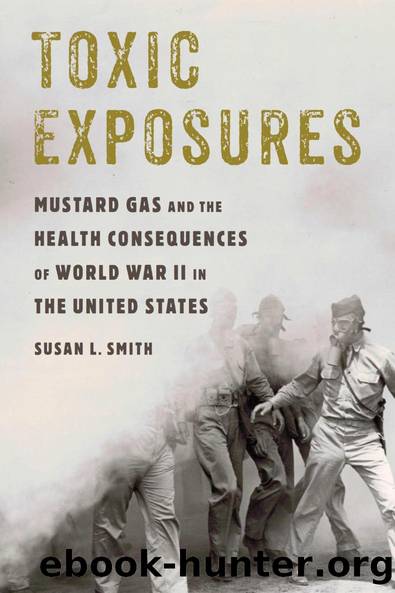Toxic Exposures by Susan L. Smith

Author:Susan L. Smith [Smith, Susan L.]
Language: eng
Format: epub
Tags: History, Military, Biological & Chemical Warfare, Medical, Science, World War II, Political Science, Human Rights, United States, 20th Century
ISBN: 9780813586113
Google: lsGpDQAAQBAJ
Publisher: Rutgers University Press
Published: 2017-01-17T01:07:38+00:00
J.D. and Yale University
The first of the historic cancer experiments with mustard agents took place in 1942 at New Haven Hospital in Connecticut, which was affiliated with Yale University. J.D., a Polish immigrant, became the first documented case of a patient receiving intravenous cancer chemotherapy.59 The medical experiment was the work of a multidisciplinary team at Yale and included Dr. Louis Goodman, Dr. Alfred Gilman, Dr. Thomas Dougherty, and Dr. Gustaf Lindskog. In early 1941, J.D. received daily X-ray treatments for sixteen days at the hospital after he was diagnosed with a tumor in his neck. By the following year the swelling in his neck had returned and J.D. again met with the doctors. He was readmitted to the hospital in August 1942 and offered a new, secret experimental drugânitrogen mustard.60
Connecticut in general and Yale University in particular had developed a degree of expertise in cancer. In 1935 the Connecticut State Department of Health created a division of cancer research and in 1941 it established the first statewide cancer registry in the United States.61 By 1938 Dr. Samuel Clark Harvey, a professor of surgery and medical historian at Yale, established a tumor clinic to diagnose and treat cancer.62
Furthermore, medical researchers at Yale University had access to mustard agents as part of their chemical warfare research. The chemicals came from Dr. Milton C. Winternitz, who was the dean of Yale University School of Medicine and chairman of the Committee on the Treatment of Gas Casualties of the Committee on Medical Research, which was part of the OSRD. The OSRD provided a contract to the Department of Pharmacology at Yale to find methods to protect against mustard gas exposure and to study nitrogen mustards.63 Dr. Winternitz assigned the contracts to Dr. Louis Goodman and Dr. Alfred Gilman. Gilman had a PhD in biochemistry and Goodman had an MD, but both had a strong interest in pharmacology and together they developed a landmark pharmacology textbook for medical students. In early 1942, the CWS gave Dr. Gilman the rank of major and appointed him head of the Pharmacology Section of the Medical Division at Edgewood Arsenal in Maryland.64
Goodman and Gilman were studying the biological effects of nitrogen mustard on rabbits when they were struck by the potential medical benefits. Nitrogen mustard affected the lymph glands, as well as bone marrow, and they envisioned that it could be useful in the treatment of cancers of the lymph nodes. They recruited Dr. Thomas Dougherty in the Department of Anatomy to test the nitrogen mustard on mice that had researcher-induced lymphoma, or cancer of the lymphatic system. Doughertyâs findings of tumor reduction were so impressive that in August 1942 the researchers asked surgeon Gustaf Lindskog to conduct a therapeutic experiment on a patient.65
Dr. Lindskog, who earned his medical degree at Harvard University in 1928, selected J.D. for the experimental treatment. J.D., who was forty-seven years old, had been diagnosed with terminal lymphosarcoma, or a malignant tumor of the lymph nodes. On August 25, 1942, J.D. was admitted to the New Haven Hospital and was experiencing respiratory distress and difficulty swallowing.
Download
This site does not store any files on its server. We only index and link to content provided by other sites. Please contact the content providers to delete copyright contents if any and email us, we'll remove relevant links or contents immediately.
The Poisoner's Handbook by Deborah Blum(1666)
Bottle of Lies by Katherine Eban(1476)
The Vaccine Race by Meredith Wadman(1356)
Missing Microbes by Martin Blaser(1318)
Mycelium Running: How Mushrooms Can Help Save the World by Paul Stamets(1290)
Pharmacy Practice and The Law by Richard Abood(1258)
The Doors of Perception and Heaven and Hell by Aldous Huxley & Aldous Huxley(1241)
28 Seconds by Michael Bryant(1205)
Decisive by Chip Heath(1203)
Steroids: History, Science, and Issues by Standora Joan E.; Bogomolnik Alex; Slugocki Malgorzata(1197)
McGraw-Hill Nurses Drug Handbook by Patricia Schull(1189)
Ganja Yoga by Dee Dussault(1177)
What's Making Our Children Sick? by Michelle Perro(1158)
The Doors of Perception: Heaven and Hell (thINKing Classics) by Aldous Huxley(1153)
Complete Guide to Prescription & Nonprescription Drugs 2014 by H. Winter Griffith(1077)
Stealing Fire: How Silicon Valley, the Navy SEALs, and Maverick Scientists Are Revolutionizing the Way We Live and Work by Steven Kotler & Jamie Wheal(1076)
Trip by Tao Lin(1047)
Anatomy of an Epidemic by Robert Whitaker(979)
Cannabis for Chronic Pain by Rav Ivker(956)
